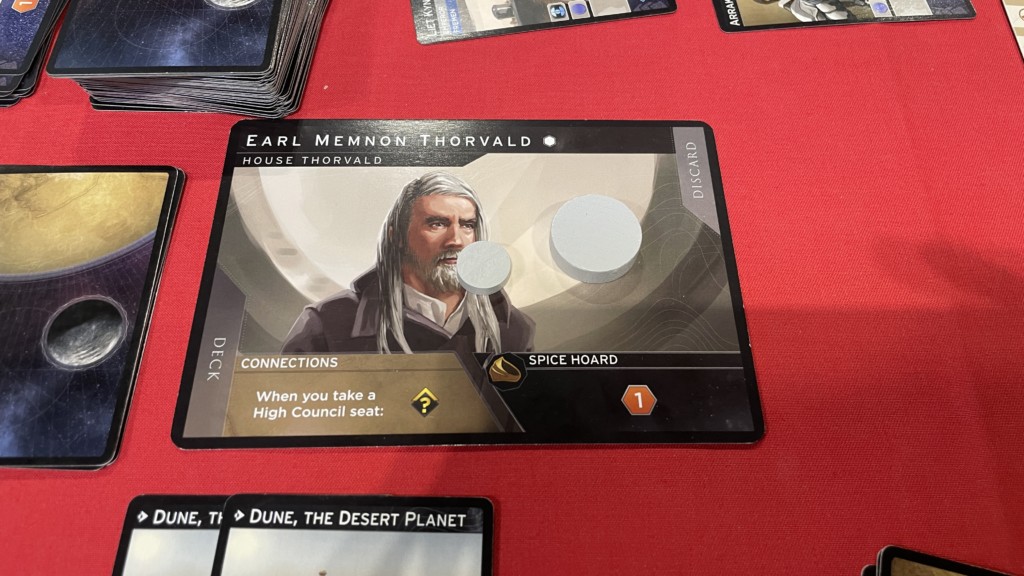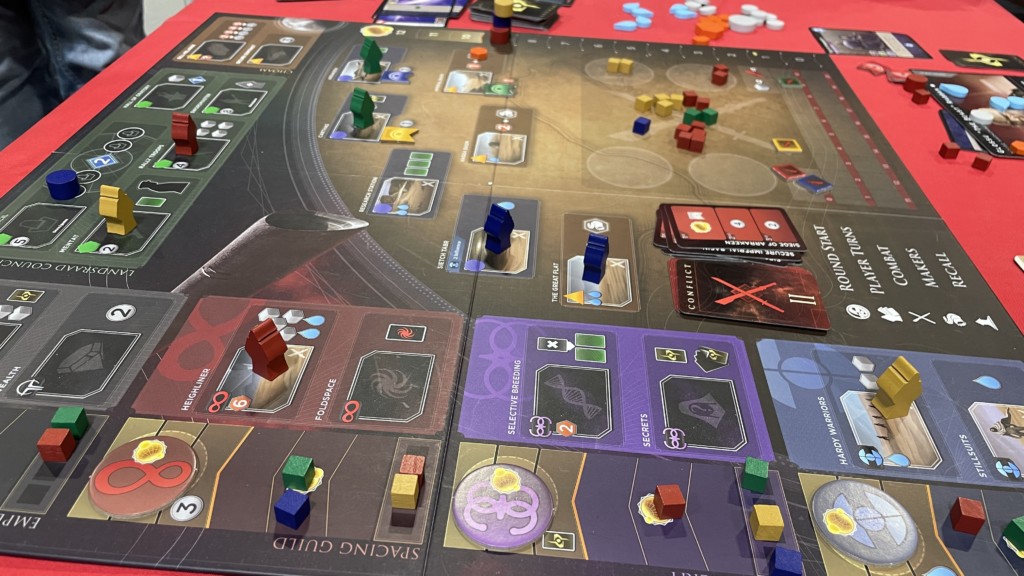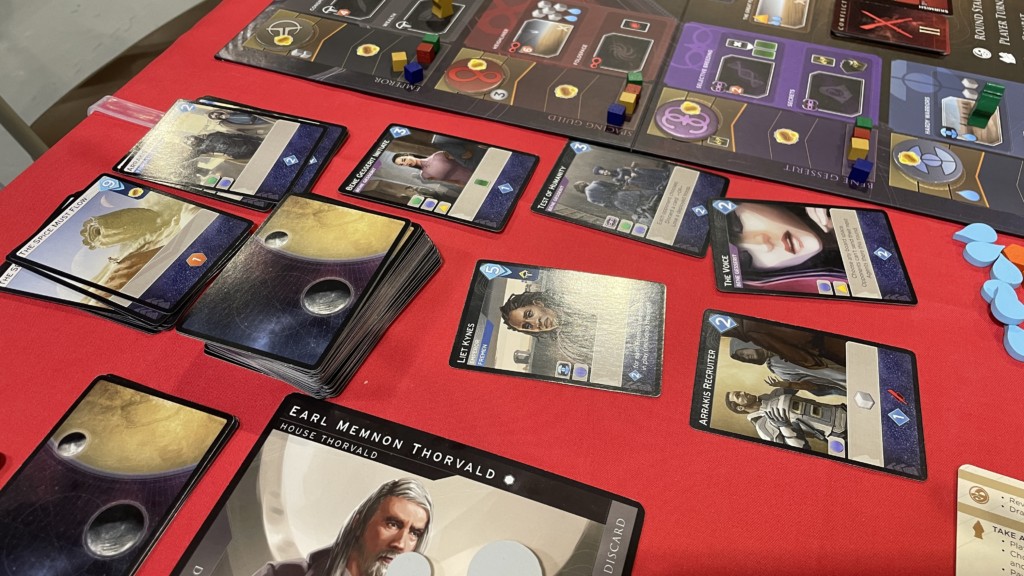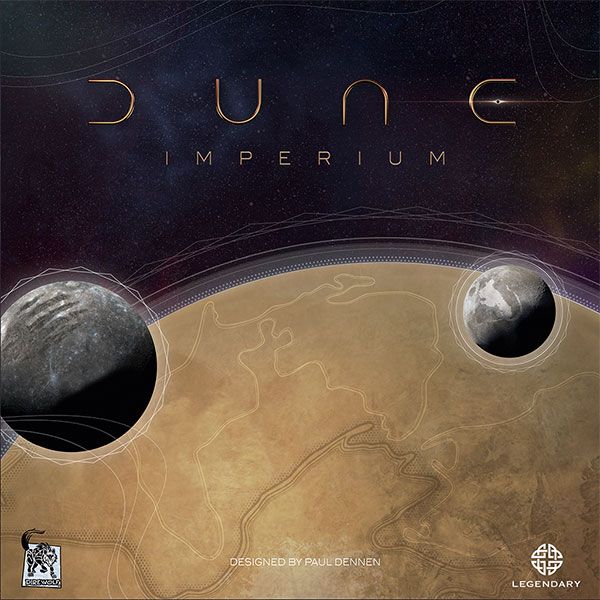I heard good things about Dune: Imperium but I’m not a fan of the IP, so what do you do?
Play it to form a proper opinion of course!
As a leader of one of the Great Houses of the Landsraad, raise your banner and marshal your forces and spies. War is coming, and at the centre of the conflict is Arrakis – Dune, the desert planet.
Dune: Imperium Game Play
Note: this is just a general overview of how the game plays including the key points but no in-depth detail.
The mainboard is laid out with tokens on and around it as well as a few shuffled decks of cards. We’ll get into all of it as we go.
Players get a leader card showing their ability and a 10 card deck. The leader cards have two abilities, one that is active all the time and one that activates when you play your Signet Ring card. More on that later.

A game is played over several rounds with 5 phases in each.
Flip over the top card of the conflict deck. This shows what the top 3 players will receive for having the most troops in the conflict at the end of this round. Generally, 1st place gets a point and something else with prizes lowering in value.
Players also draw 5 cards from their deck.
Player Turns
Starting with the start player, each player will take one of two actions. These are either “Use an Agent” or “Reveal”.
For an agent tun, you play a card from your hand face up and place one of your two agents on a space with a matching icon. You pay any costs associated with that action space then resolve it.
Most of these are to gain resources that you can spend to take other actions on the board.

There are 4 Factions on the board with tracks to move up. The first player to get 4 Influence on a track takes that factions Alliance token and also get a victory point. If another player passes them on the track that player takes the token, and the point it’s worth.
Some spaces have cubes on them. For each cube, move a recruit cube from your supply to the garrison which is a little box on the board near the battle. When you use an agent on a space with crossed swords you can deploy troops directly to the battle, as well as a couple from your garrison.
If a player has no agents they take a Reveal Turn by revealing all cards in hand and resolving their effects. The blue diamond is money you can use to buy new cards that go in your discard pile, deck-building game style. Each player also has a signet ring card in their deck that triggers a special ability. My ability was to gain a spice which while pretty boring, was very useful.

Combat
Then you total your strength for combat this round. Each troop in the conflict is worth 2 and each sword on revealed cards is worth 1. As mentioned earlier a combat card gives a reward for 1st, 2nd and 3rd with first place usually getting a point among other things.
Some combat cards let you add a banner to a space on the board and if a player takes that space you get a little bonus.
Troops in combat are returned to the supply, some spaces on the board (if unused) get a spice added and if a player has 10 points they win.
Theme
So something about Spice? I haven’t read the books and I quite recently watched the David Lynch film but didn’t enjoy it, or remember it. So, with that, I have no idea how well the theme is integrated really.
Water is rare and useful and as the world is a desert that makes sense to me. The names for the factions are weird but that’s OK things like that usually are.
Money isn’t called money but everyone at the table just called it money.
Setup
This involves putting out the board with shuffled piles of cards and piles of tokens. Looks pretty straightforward to me. There’s not too much of it either.
Components & Artwork
All of the components seem quite good and the graphic design is VERY good. You can clearly see spaces on the board and on the cards and even clearly see what your opponents are up to.
The art isn’t for me but it wasn’t distracting.
Ease of Teaching & Accessibility
The board and playing the agents is fairly simple to explain. The deck-building mechanism will hopefully be familiar to people playing this game and if not, this is not the game to use to teach it.
Any game that has hidden cards in hand is a blocker to accessibility. But these starting hands are, I think, very similar if not exactly the same for each player so other players can help out. They can then be taught new cards as they are added to their deck. You can always seat the new player between two pros to help them out.
Dune: Imperium Summary
It’s funny that the game I keep comparing this to in my head is The Expanse. This is purely because that is a game that is mechanically great but I have no connection to the theme. It’s the same with Dune: Imperium.
Mechanically it’s very good with its nice deck-building mechanism along with that ability to place agents on the board. It is different that you only play a couple of cards for one thing then reveal all the other cards for another thing. I like that it’s not just a standard deck-building game.
But there is also the area control bit for the combat which is quite important and is very good. Even if you can’t win and gain that all-important point, you can try and get a cube or two in there and pick up the 3rd place prize which is usually something worthwhile.
You’re racing up tracks to get points too which is good fun. As they give you a point halfway up AND at the top, they’re always worth your attention.
Thematically, I’ve seen the Lynch film and I’m looking forward to the Bautista/Zendaya film which I think comes out this year but I know nothing about the world.
Personally and a bit selfishly I would like to see a neutral, non-IP based theme pasted on this amazing collection of mechanisms. I would buy that.
Jesta ThaRogue



Leave a Reply